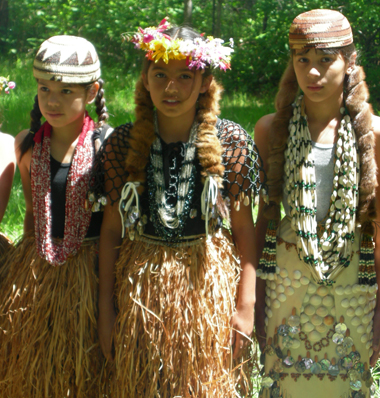 Early springtime, depending on rainfall and seasonal changes, is the ideal time to collect big leaf maple tree bark for use in making maple bark skirts, a tradition practiced amongst Karuk women in their ancestral territory located along the Klamath and Salmon Rivers of Northern California. Karuk master artist Holly Hensher and Karuk/Yurok apprentice Paula Pimm Allen describe the optimal bark conditions to remove strips measuring up to 10-feet long, as emitting a popping sound as it releases easily from the trunk. As participants in ACTA’s Apprenticeship Program, Holly and Pimm worked together to gather and prepare soap root, bear grass, acorns, basket material, medicinal herbs, and the innermost layer of maple bark, the latter for use in creating maple bark skirts worn by girls and women in tribal ceremonies, most notably the Ihuk Ceremony (Flowerdance), celebrating a girl’s entry into womanhood.
Early springtime, depending on rainfall and seasonal changes, is the ideal time to collect big leaf maple tree bark for use in making maple bark skirts, a tradition practiced amongst Karuk women in their ancestral territory located along the Klamath and Salmon Rivers of Northern California. Karuk master artist Holly Hensher and Karuk/Yurok apprentice Paula Pimm Allen describe the optimal bark conditions to remove strips measuring up to 10-feet long, as emitting a popping sound as it releases easily from the trunk. As participants in ACTA’s Apprenticeship Program, Holly and Pimm worked together to gather and prepare soap root, bear grass, acorns, basket material, medicinal herbs, and the innermost layer of maple bark, the latter for use in creating maple bark skirts worn by girls and women in tribal ceremonies, most notably the Ihuk Ceremony (Flowerdance), celebrating a girl’s entry into womanhood.
Through prayer about how to bring this ceremony back to the community, accompanied by extensive research to learn the old songs and to create the regalia including the essential maple bark skirts, the Ihuk Ceremony was revived in 1996 by a dedicated group of Karuk ceremonial families, after not having been practiced for over 80 years. Ten years ago, Holly expanded her skills as a weaver by making maple bark skirts under the guidance of Lyn Risling, one of the instrumental cultural leaders and artists leading the Ihuk Ceremony revival.
Gathering, peeling, soaking and preparing the layers of bark, sizing and grading of the strips, twining, and proper ceremonial care and blessing are all part of the process of making a skirt. Holly and Pimm worked together in all these phases at sites in Orleans and Somes Bar, creating during their apprenticeship two skirts to add to a growing collection of ten, already in use at Ihuk and Brush Dance Ceremonies. Each step also engaged community and family members directly associated with the girls who were being honored in the ceremony, as well as Pimm and Holly’s own family members. “It just seems like there’s more of a healing and more for the community, for the girl and everybody that participates,” explained Holly.
Making maple bark skirts demands a certain daily observation of and relationship to the landscape, and finding that perfect timing of when the bark can be removed from the trunk. “It means you have to pay attention to your surroundings and think about what is going on in the natural world instead of zooming through life,” Holly notes.
This is why Holly and Pimm share a keen interest in quotidian and utilitarian items, including the soap root brushes used to clean baskets, and in the continuation and development of the Ihuk ceremony. They emphasized that although maple bark skirts and soap root brushes did not bear as many strict observances as other types of ceremonial regalia, the spiritual import of these items and of their creation was just as strong.
The Ihuk ceremony, Holly notes, “is about prayer, about being a good person. When you look around at who is there in that circle around you… to support you, [you] know and appreciate that fact. When you are making a skirt like this, you are thinking about these things. You are thinking about how it is to be appreciated by a whole community and having a role and responsibility in that community. And that gives you value.”
Pimm, who, in addition to her key roles in ceremonial protocol and as a singer, serves as Traditional Resource Specialist at Arcata’s United Indian Health Services, notes the opportunity to impart wisdom to the young women. “We talk to the girls about thinking about who made those skirts, what went into them, representing their families, the kind of thoughts they should be having.”
The inclusive nature of the process of making maple bark skirts, as well as the opportunity to honor womanhood, increases the opportunity for a shared experience, bringing in more people into the annual cycle of collecting bark and constructing skirts each year, and to the ceremonies. The familial, celebratory nature of the Ihuk Ceremony results in an accessibility which allows people to “feel like they can participate in a way they haven’t been able to before,” which, Pimm notes, creates stronger community links and bridges generations of women. “I’m not the first one to hear that popping noise, and I’m not going to be the last.”
